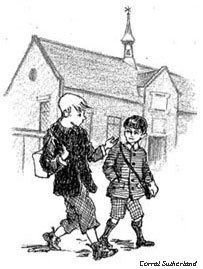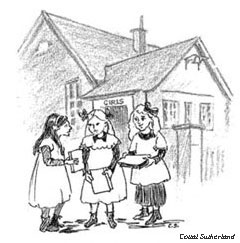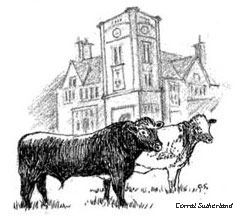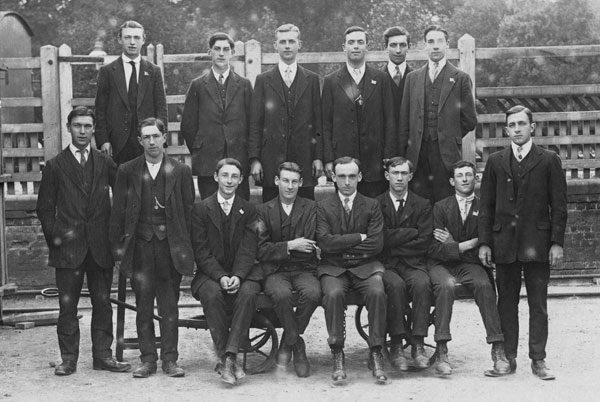Life in Kibworth and District before the Great War
In 1911, the Kibworths and Smeeton Westerby were home to some 2000 people. Other villages were smaller: Foxton, for instance, had 324 inhabitants and Tur Langton, 237.
Schooling
Most children would have attended school only until they were 14 and many left at 12 or 13 to work. From 1907, Kibworth had an infants school in Paget Street for the 5 to 8 year olds and the National School on Station Street, now a doctors’ surgery, catered for the older children. The Grammar School took fee-paying students and also offered scholarships to a few children who succeeded in an entry examination. Girls were admitted from 1907.
The Infants School had a good write-up in 1913, ‘the premises are neat and clean and made bright and cheerful by a good supply of pictures, plants and flowers’. And, ‘much of the work is distinctly praiseworthy, especially the reading’. In December that year, the children gave a concert for parents and friends comprising ‘songs, playlets, recitations and morris dancing etc’. The money raised paid for a Christmas tea for the children. In May 1914, four children were late for school as they had been to the sheep washing. From time to time many pupils were absent because of outbreaks of childhood diseases such as measles, chickenpox or whooping cough, which sometimes resulted in the school being closed.

At the National School, nature study was very popular. There was a special table for specimens with an aquarium. On 29 May, 1914, an exhibit of ‘germinating specimens, the glass-tank for aquaria and the Nature Study Calendar and Syllabus for April’ was sent to the Leicester Agricultural Show. In July 1914, it was noted that Edward Sidney and Rosa Gamble had won places at the Grammar School.

Lilian and Mildred Hare, daughters of draper Frederick George Hare, of Kibworth, were fortunate to be able to attend Kibworth Grammar School. Lilian passed her Oxford Local Examination in 1910 in Arithmetic, Religious Knowledge, History, Composition, Literature, Geography, French, Hygiene and Drawing. After leaving school, Mildred was apprenticed for three years to drapers Adderly and Company of Leicester. She did well and later became buyer for furs, coats and suits for Joseph Johnson’s of Leicester, now Fenwick’s.
Employment
Most of the area was pastureland, as shown by the large number of graziers listed in 1908, e.g. John Waterfield of Kibworth Beauchamp and George and William Crisp of Foxton. The cattle reared at that time were used for both milk and beef. Milk was ladled into cans for local families and butter was made for sale at Harborough market. Animals were matured for three to four years for beef and there were many butchers, often with their own slaughterhouses. One-up, one-down shepherds’ ‘cots’ were dotted around the countryside. The families living in them drew water from a nearby brook and in winter the landowner might deliver a cart-load of coal to keep them warm, paid for in kind by hedgelaying.
In the early twentieth century, hosiery factories with power-driven machines had superseded the small manual framework knitting workshops that had been so common in Kibworth. Early each morning in Kibworth Beauchamp, the sound of hobnail boots could be heard as workers tramped up High Street to the Johnson & Barnes factory on the corner of Dover St and Fleckney Road. Together with R.H. Poynor’s factory on Smeeton Road, the hosiery business provided employment for many local people.
Everyday needs were met by shopkeepers, laundresses, dressmakers and tailors, carpenters, coal merchants, chimney sweeps, and carriers. Mowsley had a cheese maker and Foxton a mushroom catsup manufacturer. The Kibworth Motor Company sold and repaired motor cars.

Women were well represented even though they didn’t have the vote. In 1908, Miss Nellie Read was sub-postmistress of Burton Overy and East Langton had Mrs Sophy Smith. Mrs Clara Pritchard was Mistress of Foxton Council School and Mrs Elizabeth Ellen Driver was Mistress of the Public Elementary School for Cranoe, Stonton, Slawston and Glooston. In Kibworth Beauchamp, Mrs A Grant was the operator for the National Telephone Company.
In those days, people showed great resourcefulness in finding employment. Ernest Ward, born in 1872, was mowing grass before he became a teenager and turning clay bricks at Kibworth brickyard. In 1892 he helped to lay Wellington’s Sidings at what is now Station Hollow. He thought nothing of walking to Wigston to start work at 6am on building the chapel. He even walked to Spalding in Lincolnshire to look for work, getting three days threshing at Deeping St James. If you live in Buller St, Kimberley St, Rosebery Avenue, Dover St or Gladstone St in Kibworth’s New Town, he might have helped to build your house.
International connections
The Market Harborough Advertiser of 4 August 1914 concerned itself with the Kibworth Scouts Church Parade of the previous Sunday and a Church Sunday School treat that had been held in the Rectory Field on the Saturday. It was noted that there had been an appeal to Austrians in England to return home for military service. The front page of the 11 August edition, however, was emblazoned with ‘Your King & Country Need You – A Call to Arms’ and the need for 100,000 men to enlist.
Monday 3 August was a Bank Holiday and the banks remained closed that week, causing problems for farmers attending the local cattle markets. Telegrams could, in future, only be sent in plain English or French. Count Hochberg’s German groom was taken into custody but was expected to be released. On Sunday 9 August, the Vicar of Wistow took Isaiah 30/15 as his text and gave a sermon on ‘Confidence and Quietness’.

The call to enlist was soon answered by local men. Fourteen volunteers were photographed at Kibworth Station in September 1914 waiting to travel to Wigston Barracks to join the 9th Battalion Leicester Regiment. Of 23 new recruits from Kibworth attested in the week of 8 September, 18 came from Johnson and Barnes’ factory. By October, nearly 1000 men from Market Harborough and the surrounding villages had joined the colours
The outside events also had an impact on local schools: in September children in Kibworth were given special lessons on ‘the causes and progress of the present European War’ and Mr Quincey the National School Headmaster was enrolled in the 4th Battalion of the Leicester Regiment for war service. In November the Infants School collected 13s 0d for the Belgian Children and the National School raised 10s 6d for Princess Mary’s Christmas Fund for the Sailors and Soldiers.
Of course it was not all over by Christmas. Over the coming months the Chronicle will be describing the changes the Great War brought to life in the countryside and telling the story of men and women from the villages who served their country.
The Chronicle would like to thank everyone who has contributed information about life before the Great War and family members who served their country. Their help is much appreciated.
JME
Pencil Illustrations by Corral Sutherland




 Burton Overy WW1 Commemorations
Burton Overy WW1 Commemorations

